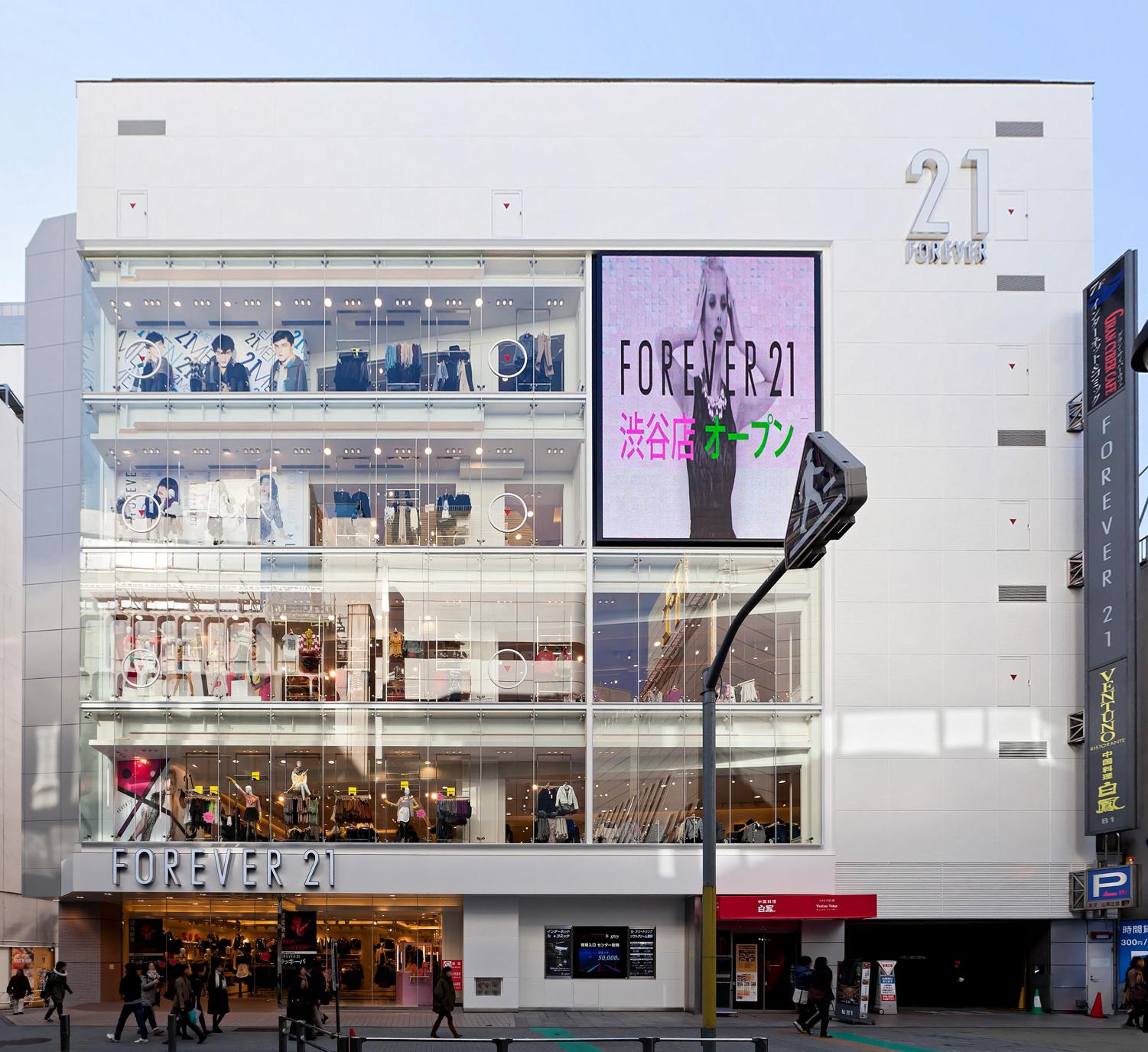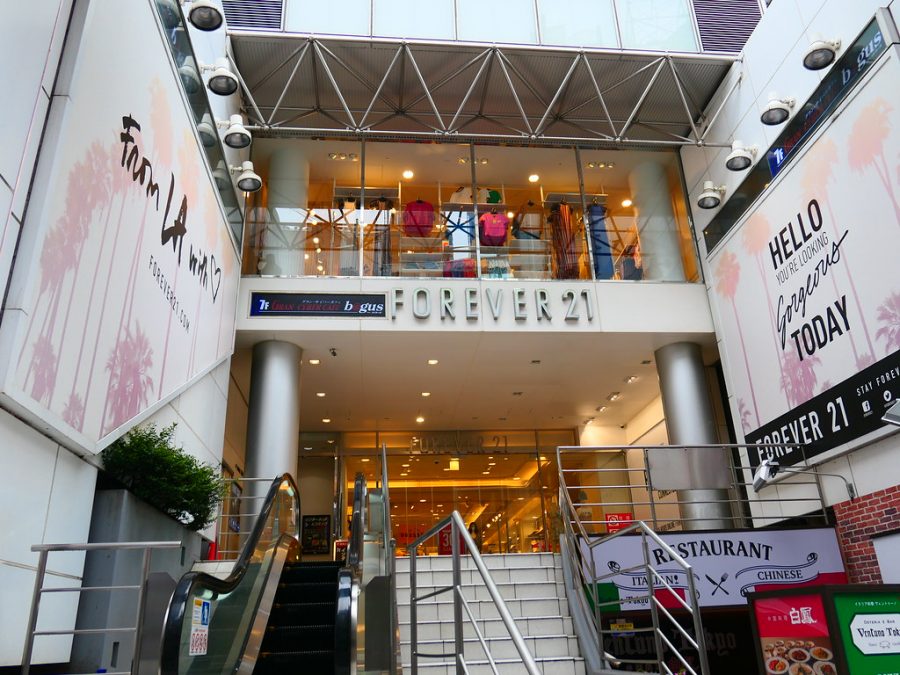The Retail Apocalypse: Forever 21
Photo by Creative Commons
October 29, 2019
One factor making us at ASIJ stand out among other international schools is our uniform — or lack thereof. Students fill the halls every day, using their clothing choices to reflect their personal style and mood, but it’s also hard to miss the commonalities linking many students to the latest fashion trends. So where are these teens getting their clothes? No brand provides these trendy items as quickly and affordably as the Los Angeles-based fast-fashion retailer, Forever 21.
The company filed for Chapter 11 bankruptcy earlier this month, announcing that it will be closing 350 of their 800 or so locations, according to the Los Angeles Times. This includes their 14 stores (and online store) in Japan. As sudden as this seems, Forever 21 sales have been declining over the past few years, and their continuous expansion into dwindling markets only hardened the blow they took this month.
The retailer multiplied its physical locations just three years ago in 2016, despite the increasing demand for online markets and stores. Customers also began noticing lower quality items, an effect of their rapid global growth. According to CNBC, Forever 21 isn’t alone, with popular brands like Gap, Victoria’s Secret, and Abercrombie and Fitch being a few among hundreds of brands closing stores in 2019.
It is unclear whether Forever 21 will ever expand to certain global markets again, but at least for the next few years, the assumption seems to be that it won’t. Linda Chang, currently the brand’s executive vice president reported the decision to exit most foreign markets as “an important and necessary step to secure the future of our company, which will enable us to reorganize our business and reposition Forever 21.” However, past companies that succumbed to bankruptcy have shown that it’s hard to come back the same, if at all. Once large, profitable corporations like Aeropostale and Quicksilver now only exist as sub-brands of companies, tucked away in forgotten corners of department stores or strip malls.

So what does this mean for our student body? Living in Tokyo with a more Western-influenced fashion sense means that these foreign brands — Forever 21 always among the most prominent — are what we rely on for clothing most of the year. This may be a push for students to think more sustainably about their fashion — by having to think more about the worth of an item for its price — or may lead to the rise of a new affordable fast-fashion producer.
Either way, it’s clear that Forever 21 wasn’t meant to last forever after all.





















Alexy • Dec 13, 2019 at 2:18 PM
This article was very informative and concise. The author managed to make the piece relatable to readers and even if a reader didn’t shop at Forever 21 they are be able to understand the issue and topic. I think that while Forever 21 was an affordable option for most people, their lack of good quality products that stay in one piece for at least a month, caused their downfall.
Peyton • Dec 13, 2019 at 2:16 PM
This article was very intriguing. I wasn’t completely aware of Forever 21’s bankruptcy- as I don’t find myself shopping there very often- however it was interesting to read about the reasons behind this and how it is having an affect on adolescents. I think that, particularly in Japan, it is hard to find common teen clothing brands as you would typically in the USA, so shutting down Forever 21 stores here is definitely going to be disappointing for many.
Kiara • Dec 13, 2019 at 2:16 PM
I think that this article was very intriguing to read and how specific things such as the last line of the entire article as well as the title made it humorous which I think made the article better. Also instead of just telling us that the store was closing down, you informed us why and also why it is relevant to us teens in ASIJ.
Ava Schwabecher • Dec 13, 2019 at 2:09 PM
This article was very informative and interesting to read. I also liked the way you introduced the topic, great job!
Eden • Dec 13, 2019 at 2:07 PM
I think that this article is written in a captivating way and addresses the topic very well and clearly.
Zainab Bukhari • Dec 13, 2019 at 12:30 PM
This article informed me of the reasons behind Forever 21’s bankruptcy, which I have heard a lot about recently but never really understood. I was very shocked when I first found out about this, but the author of this report did a great job of explaining the negative and positive impacts of the shop’s closing. The article addressed the issue well, making the reader aware of the declining sales at the well-known store, and how it has affected the public.
Sungyeon Park • Dec 13, 2019 at 12:26 PM
Though I knew that the company, Forever 21, had gone bankrupt, I never knew the reason behind it until I read this article. This article is well informed as it had stated the low-quality clothing had contributed to the declined sales. Not only that, but they also explained how this affects the students of ASIJ and the fast-fashion industry in general.
Sungyeon Park • Dec 13, 2019 at 12:18 PM
Though I had known that the company, Forever 21 had gone bankrupt, I never knew the reason behind it until I read this article. A very well informed article which had stated the low-quality of the clothing. They have also broadened the topic into how it affects students at ASIJ and the fast-fashion industry in general.
Daiya • Dec 13, 2019 at 12:16 PM
I think this article has a lot of detail and info.
ella • Dec 13, 2019 at 12:14 PM
I think that this article was really interesting because this is an issue that many students are wondering about right now. Also, I really liked the irony of the last line!
ellie • Dec 13, 2019 at 12:14 PM
This article was very informative about what is going on with forever 21, and it was also very interesting. The last line was very clever and a good way to end this article!
Coco • Dec 13, 2019 at 8:54 AM
I liked how you addressed and informed the reader about the issue and I think this article was very well written.
Anders Jakob • Dec 13, 2019 at 8:41 AM
This was a very informative article, with a great variety of writing techniques used. Some of the wording could be better, but overall this article was enjoyable to read. I had heard rumours about this Forever 21 bankruptcy before, but I was never actually aware of what was happening. I personally have never gone to Forever 21 myself but I know that a lot of people go there to buy clothes, and since this shop is closing, I think that we might begin to see a larger variety of clothing being worn at this school.
Jennifer • Dec 13, 2019 at 8:41 AM
I really liked this article because even though I don’t go to Forever 21, it was still very clear and informative about the subject.
Hana Freeman • Dec 13, 2019 at 8:38 AM
I thought that this article was written very clearly and concisely. I like how you incorporated some humor and personality into the writing. Forever 21 products are incredibly cheap and affordable and unfortunately, their products reflect on this low price as almost all their clothings are of low quality. The company should have taken more time with the quality of their products, not so much the quantity of sales and number of stores around the world. In my opinion, I don’t think Forever 21 has a great chance of making a huge comeback and rebuilding their brand any time soon.
Lisa Doerich • Dec 12, 2019 at 12:21 PM
I also think that we rely on trendy clothing which includes the brand Forever 21 and because of its bankruptcy this year we now have to find many other places that would provide the same things that we have wanted so this can let us find more places and think about our sustainably about fashion.
lila • Dec 12, 2019 at 12:13 PM
I found this article super interesting and a great overall summary of the issue, which I had been looking for. Also love the last line in the article!
Jonny Wang • Dec 12, 2019 at 12:04 PM
Very Informative Article
Mayu Nakayoshi • Dec 12, 2019 at 10:07 AM
I was very shocked after reading this article, knowing that about half of the stores Forever 21 had will be closed. I loved going to Forever 21, but knowing that there will be only 14 stores in Japan now makes me wonder if I will be able to first find a shop, and second if I will be able to shop there without the shop being so crowded. I think Forever 21 had many trendy clothes and had clothes girls would want to wear during that time of season. I remember the shop being very colourful with many kind of clothing’s, make up, bags, etc. I hope Forever 21 will one day have stores in Japan reopen again because I did love shopping there, and I think many ASIJ students would agree as well.